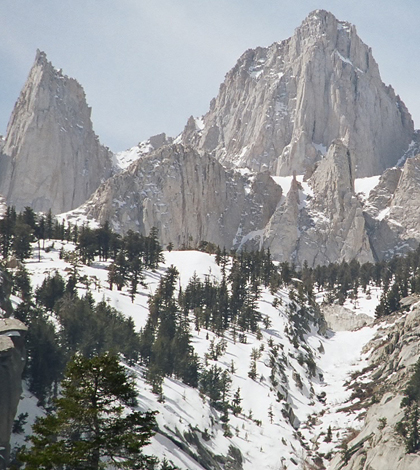Greater tree growth and more evapotranspiration could mean slimmer Sierra Nevada streams

Mount Whitney in the Sierra Nevada is the highest peak in the contiguous U.S. (Credit: Geographer, via Wikimedia Commons/CC BY 1.0)
In California’s reality of shrinking snowpack and rising temperatures, there appears to be a new threat to the state’s freshwater supplies on the horizon: expanding mountain forests. Researchers at the University of California, Irvine made the connection in a study that assumed a more than 4-degrees-Celsius rise for temperatures in the Sierra Nevada by 2100.
Cooler temperatures in high elevations keep tree growth at a slow pace. But if temperatures rise by their predicted levels that growth will ramp up, and evapotranspiration — essentially evaporation combined with plant transpiration — will follow. That translates into a massive drop in runoff feeding tributaries below.
The findings have already advanced understanding of the Sierra Nevada’s hydrology and the interactions its forests have with ecosystems surrounding them. But what is one of the first looks into the likelihood of expanded tree growth there has also revealed what impacts climate change may have on future water availability in California.
“If temperatures get warmer, forests could expand thousands of feet upslope,” said Michael Goulden, professor of Earth system science at the university and co-author of the study. “Evapotranspiration is just a budget, so if you expand forests, there will be a big increase.”
To collect data for analysis, he and Roger Bales, a professor of engineering at UC Merced, set up multiple eddy covariance towers in an area of the Sierra Nevada they deemed vulnerable to changes in climate. Eddy covariance towers measure the exchange of energy and gases between the atmosphere and land. Depending on the objective, the gases under study can differ. “So if you’re focusing on water vapor, what you’re measuring is evapotranspiration,” said Goulden.
The forested region they chose is a dry one that gets fairly moderate precipitation. The towers were armed with sonic anemometers and gas analyzers to measure wind movement, air temperature, carbon dioxide and water vapor. Data were logged every thirty minutes and sent to researchers via satellite radio transmitters. Towers were a necessity, says Goulden, given the dynamics of the area being studied.
“The old-school way of doing this involves using lysimeters, which are amazing things,” said Goulden. But forest trees are huge, sometimes reaching 60 meters high, and lysimeters, which weigh a small patch of soil and plants to find moisture loss, just wouldn’t yield applicable evapotranspiration data. “Certainly in agriculture that was one of the early ways we got a handle on it, but as we’ve moved to this taller stature, eddy covariance has become more appropriate.”

Greater tree growth in the Sierra Nevada could increase evapotranspiration and diminish streamflows. (Credit: Matt Meadows/UC Merced)
With the massive structures, he and Bales discovered that the amount of runoff lost to streams by 2100 could be quite extreme if predicted warmer temperatures and forest movement upslope play out in the future.
“We were surprised by the magnitude. We found that there’s a 26 percent potential decrease in river flow,” said Goulden. “It’s a big effect, and if that plays out, it’s not good.”
To be clear, the study assumed that temperatures will go up in California by their highest predicted levels. Because of the early nature of the investigation, Goulden says assuming the worst was needed, and he hopes the findings spur further study into the risks of decreased runoff from the Sierra Nevada.
Of course snowpack still contributes to runoff, but increased evapotranspiration may have a longer-term effect. “I think it’s a bigger threat, even though melting snow has received the most attention,” said Goulden. “You can capture that (melted snowpack) and it helps fill up reservoirs. But if vegetation moves upslope, the loss of water from the system overall — you can’t do much about that.”
Top image: Mount Whitney in the Sierra Nevada is the highest peak in the contiguous U.S. (Credit: Geographer, via Wikimedia Commons/CC BY 1.0)




0 comments